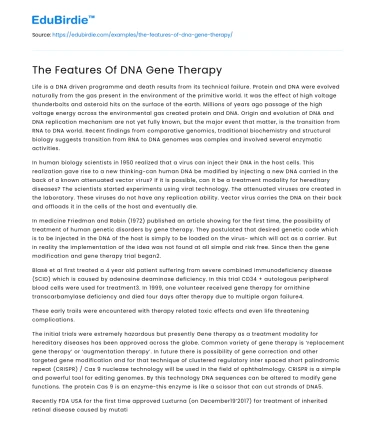Life is a DNA driven programme and death results from its technical failure. Protein and DNA were evolved naturally from the gas present in the environment of the primitive world. It was the effect of high voltage thunderbolts and asteroid hits on the surface of the earth. Millions of years ago passage of the high voltage energy across the environmental gas created protein and DNA. Origin and evolution of DNA and DNA replication mechanism are not yet fully known, but the major event that matter, is the transition from RNA to DNA world. Recent findings from comparative genomics, traditional biochemistry and structural biology suggests transition from RNA to DNA genomes was complex and involved several enzymatic activities.
In human biology scientists in 1950 realized that a virus can inject their DNA in the host cells. This realization gave rise to a new thinking-can human DNA be modified by injecting a new DNA carried in the back of a known attenuated vector virus? If it is possible, can it be a treatment modality for hereditary diseases? The scientists started experiments using viral technology. The attenuated viruses are created in the laboratory. These viruses do not have any replication ability. Vector virus carries the DNA on their back and offloads it in the cells of the host and eventually die.
Save your time!
We can take care of your essay
- Proper editing and formatting
- Free revision, title page, and bibliography
- Flexible prices and money-back guarantee
In medicine Friedman and Robin (1972) published an article showing for the first time, the possibility of treatment of human genetic disorders by gene therapy. They postulated that desired genetic code which is to be injected in the DNA of the host is simply to be loaded on the virus- which will act as a carrier. But in reality the implementation of the idea was not found at all simple and risk free. Since then the gene modification and gene therapy trial began2.
Blasé et al first treated a 4 year old patient suffering from severe combined immunodeficiency disease (SCID) which is caused by adenosine deaminase deficiency. In this trial CD34 + autologous peripheral blood cells were used for treatment3. In 1999, one volunteer received gene therapy for ornithine transcarbamylase deficiency and died four days after therapy due to multiple organ failure4.
These early trails were encountered with therapy related toxic effects and even life threatening complications.
The initial trials were extremely hazardous but presently Gene therapy as a treatment modality for hereditary diseases has been approved across the globe. Common variety of gene therapy is ‘replacement gene therapy’ or ‘augmentation therapy’. In future there is possibility of gene correction and other targeted gene modification and for that technique of clustered regulatory inter spaced short palindromic repeat (CRISPR) / Cas 9 nuclease technology will be used in the field of ophthalmology. CRISPR is a simple and powerful tool for editing genomes. By this technology DNA sequences can be altered to modify gene functions. The protein Cas 9 is an enzyme-this enzyme is like a scissor that can cut strands of DNA5.
Recently FDA USA for the first time approved Luxturna (on December19’2017) for treatment of inherited retinal disease caused by mutation in both copies of RPE65 Gene. Of course there should be enough remaining viable retinal cells. It does not cure but sustainability improves vision. Since 2018, Luxturna is commercially available and the price in USA is $425,000/- per year. Luxturna is an adeno assisted virus type 2 and through the vector the corrected copy of the RPE 65 gene is delivered with undisturbed genome. The drug is injected in the subretinal space. RPE 65 gene is responsible for regeneration of visual pigment.
After the success of Luxturna practically, a new era of Gene Therapy has emerged. The active retinal gene replacement multiple phase ½ trial has been started. In this research Stargardt’s disease, retinitis pigmentosa, Usher syndrome etc. have been targeted. For these trial adeno-assisted virus (AAV) or Lente virus are used as Vector.
So it is critical for offering best possible care to our patients and up to date knowledge is equally critical. Success will depend on early and accurate diagnosis, appropriate work up, clinical characterization, genetic testing and genetic counseling. In the field of Gene Therapy multiple issues and questions are to be solved, but it is certain that a realistic hope has been generated for the patients suffering from genetic disorders.






 Stuck on your essay?
Stuck on your essay?

